Determination of distances and audibility of sounds in the terrain and target designation
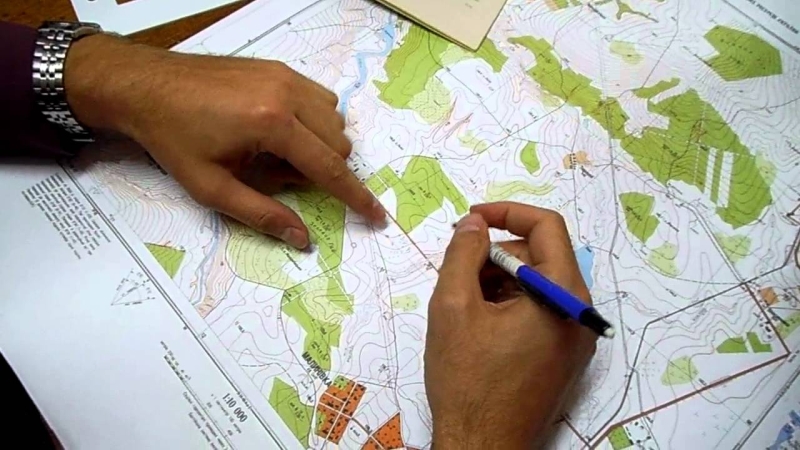
All benefits for travelers: tourists, hunters - always place great emphasis on the methods of determining distances to any objects without the aid of special tools. Of course, the skill is not out of place. I think, however, that when preparing to cross the river, you will lose a little if you determine its width of 75 meters, although in fact it is equal to 120 meters. Well, you'll have to row for a few minutes longer - which will change. It is much more important to be able to determine not the width of the crossing, but to find a place, good for it, to find out the depth and nature of the ford (about this - below). For a hunter, it is important to know exactly the distance, for example, to the moose lying in the snow, in order to take the excess of the fly and take one shot at one go. This is achieved not only by great practice, but also by special techniques and devices, which in turn help this practice itself.
Very often it is required to determine the distances to various objects on the terrain, and also to estimate their sizes. The most accurate and fastest distances are determined by means of special instruments (range finders) and range scales of binoculars, a stereotube, and sights. But because of the lack of instruments, distances are often determined using improvised means and by eye.
Among the simplest ways to determine the range (distances) to objects on the terrain are the following:
- Ocularly;
- On the linear sizes of objects;
- Visibility (discernibility) of objects;
- On the angular size of known objects;
- By sound, etc.
Eye-Sighting
Ophthalmic is the easiest and fastest way. The main thing in it is the training of visual memory and the ability to mentally postpone on the terrain a well-represented permanent measure (50, 100, 200, 500 meters). Having fixed in memory these standards, it is easy to compare with them and estimate distances on terrain. Under the link An example of using the eye measurement method for determining distances in pictures .
When measuring distances by sequentially mentally postponing a well-studied constant measure, it must be remembered that the terrain and local objects seem to be reduced in accordance with their removal, that is, by removing twice and the object will appear to be half as small.
Therefore, when measuring distances, the mentally deferred segments (terrain measures) will decrease according to the distance.
In this case, it is necessary to consider the following:
- The closer the distance, the clearer and sharper it seems to us the visible object;
- The closer the object, the more it seems;
- Larger objects seem closer to small objects that are at the same distance;
- The object of a brighter color seems closer than the object of dark color;
- Brightly lit objects appear closer to the poorly lit, at the same distance;
- During fog, rain, at dusk, cloudy days, when the air is saturated with dust, the observed objects appear farther than on clear and sunny days;
- The sharper the difference in the color of the object and the background on which it is visible, the more diminished the distances seem; So, for example, in winter, a snowy field as it approximates dark objects on it;
- Objects on flat terrain seem closer than on hilly, especially distances seem to be determined through vast water spaces;
- Folds of the terrain (river valleys, hollows, ravines), invisible or not completely visible by the observer, conceal distance;
- When observing the prone, the objects seem to be closer than when they are standing;
- When viewed from the bottom upwards - from the sole of the mountain to the top, objects appear closer, and when viewed from top to bottom - further;
- When the sun is behind us, the distance is concealed, shining in the eyes - it seems larger than in reality;
- The fewer objects on the site under consideration (when viewed through water, smooth meadow, steppe, arable land), the distances seem less.
The accuracy of the eye measurement depends on the person's training.
For a distance of 1000 m, the usual error ranges from 10 to 20%.
According to linear dimensions

Determination of distances along the linear dimensions of the object (object)
The determination of distances along the linear dimensions of objects is as follows (Fig. 9). Using a ruler located at a distance of 50 cm from the eye, the height (width) of the observed object is measured in millimeters. Then the actual height (width) of the object in centimeters is divided by the measured in a ruler in millimeters, the result is multiplied by a constant number 5 and the desired height of the object in meters  .
.
For example, the distance between telegraph poles is 50 m (Fig. 8) and is closed on a ruler by a section of 10 mm. Consequently, the distance to the telegraph line is: 
The accuracy of determining distances from angular and linear values is 5-10% of the length of the measured distance. To determine distances from the angular and linear dimensions of objects, it is recommended to memorize the values (width, height, length) of some of them, given in the table below
| Subject | Dimensions, m | ||
| Height | Length | Width | |
| Medium Tank | 2-2.5 | 6-7 | 3-3 5 |
| Armored personnel carrier | 2 | 5-6 | 2-2,4 |
| Motorcycle with sidecar | 1 | 2 | 1.2 |
| Freight car | 2-2.5 | 5-6 | 2-3.5 |
| A car | 1.6 | 4 | 1.5 |
| Passenger car four-axle | 4 | 20 | 3 |
| The railway tanker is a four-axle | 3 | 9 | 2.8 |
| Wooden post of communication line | 5-7 | - | - |
| Man of medium height | 1.7 | - | - |
To determine the distance by this method, it is necessary:
- Keep the ruler in front of you at arm's length (50-60 cm from the eye) and measure in millimeters the apparent width or height of the object to which you want to determine the distance;
- The actual height (width) of the object, expressed in centimeters, divided by the apparent height (width) in millimeters, and the result is multiplied by 6 (a constant number), we get the distance.
For example, if a column 4 m high (400 cm) is closed along a ruler of 8 mm, then the distance to it will be 400 x 6 = 2400; 2400: 8 = 300 m (actual distance).
To determine distances in this way, you need to know the linear dimensions of various objects well, or have this data at hand (on the tablet, in the notebook). The dimensions of the most frequently encountered objects a person needs to be remembered, since they are also required for the method of measurement with respect to the angular dimension, which is the main one for us.
By appearance (discernibility) of objects
With the naked eye, you can approximately determine the distance to the targets (objects) in terms of their visibility. For example, if someone saw a pipe on the roof of the house, this means that the house is no more than 3 km, and not exactly 3 km. A soldier with normal visual acuity can see and distinguish some objects from the following limit distances indicated in the table below:
| Objects and signs | Distances from which they
|
| Separate small house, cottage | 5 km |
| Roof Pipe | 3 km |
| Aircraft on the ground tank in place | 1 2 km |
| Tree trunks, kilometer posts and communication pillars | 1 mile |
| Movement of legs and arms of a running or walking person | 700 m |
| Machine-gun, mortar, anti-tank gun, wire barriers | 500 m |
| A machine-gun, a rifle, a color and pieces of clothing on a man, an oval of his face | 250 - 300 m |
| Roof tiles, leaves of trees, wire on stakes | 200 m |
| Buttons and buckles, details of the soldier's weapons | 100 m |
| The features of a person's face, hands, details of small arms | 100 m |
It must be borne in mind that the table indicates the limiting distances from which certain objects begin to be seen. For example, if a soldier saw a pipe on the roof of the house, this means that the house is no more than 3 km, and not exactly 3 km. Use this table as a reference is not recommended. Each serviceman should individually clarify these data.
When determining the distance visually, it is desirable to use landmarks, the distances to which are already known.
From the angular dimension
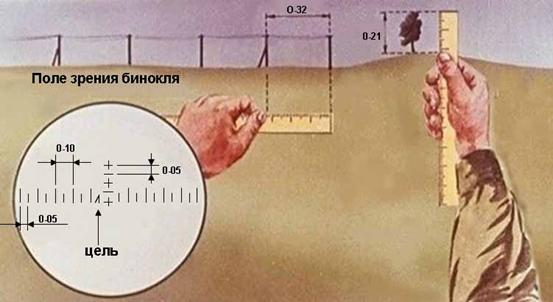
Determination of distances along the angular dimensions of the object (object)
The determination of distances along the angular dimensions of objects is based on the relationship between the angular and linear quantities. The angular dimensions of objects are measured in thousandths with the help of binoculars, surveillance and aiming devices, rulers, etc. To apply this method, you need to know the linear value of the observed object (its height, length or width) and that angle (in thousandths), under which this object is seen.
For example, the height of the railway booth is 4 meters, the face sees it at an angle of 25 thousandths (the thickness of the little finger).
Then the distance to the booth will be 4 x 1000 = 4000, divided by 25, that is 160 meters.
To determine the angular value, it is necessary to know that a 1 mm segment, removed from the eye by 50 cm, corresponds to an angle of two thousandths (it is written: 0-02).
Hence it is easy to determine the angular value for any segments. For example, for an interval of 0.5 cm the angular value will be 10 thousandth (0-10), for a segment of 1 cm - 20 thousandths (0-20), etc.
The simplest way is to memorize the standard values of thousandths:
| Item Name | Size in thousandths |
| Thickness of Thumb | 40 |
| Thickness of index finger | 33 |
| Thickness of middle finger | 35 |
| Thickness of little finger | 25 |
| Cartridge on the width of the collar of the cartridge case (7.62 mm) | 12 |
| Sleeve 7.62 mm in width | 18 |
| Pencil simple | 10-11 |
| Matchbox on length | 60 |
| Matchbox width | 50 |
| Matchbox in height | thirty |
| Match thickness | 2 |
The distance to objects in meters is determined by the formula:  , Where B is the height (width) of the object in meters; Y is the angular size of the object in thousandths.
, Where B is the height (width) of the object in meters; Y is the angular size of the object in thousandths.
For example:
- The angular size of the landmark (telegraph pole with a support), whose height is 6 m, is equal to the small division of the binocular grid (0-05). Therefore, the distance to the reference point will be equal to:

- Angle in thousandths measured by a ruler located 50 cm from the eye, (1 mm is 0-02) between two telegraph poles 0-32 (telegraph poles are 50 m apart). Therefore, the distance to the reference point will be equal to:

- The height of the tree in thousandths, measured by a ruler 0-21 (true tree height 6 m). Therefore, the distance to the reference point will be equal to:

Determination of the distance on the ground
To learn how to calculate distances, you first need to find out the length of your step, your height and the thickness of the finger that you are vising. In addition, it is necessary to get an idea of how far the horizon lies from the observer. In other words, it is necessary to know at what distance a hunter can survey the surrounding terrain. To this end, we should use the formula: Horizon distance = 113 √ h km , where h is the height of the observer in km.
Standing on the plain, a 1.6 m tall man sees the surrounding terrain at 131 √ 0.0016 = 4.52 km. Sitting in a boat and towering above the water only by 1 m, a person can survey the surrounding terrain only by 113 √ 0.001 = 3.58 km. Of course, in reality, the range of the horizon increases, since the terrestrial atmosphere, bending the path of the rays of light (refraction), as it moves the horizon by about 6% compared to the figures obtained from the formula. Due to this, a 1.6 m tall man sees the surrounding terrain at 4.8 km. The range of visibility of the horizon also increases when atmospheric pressure rises, in cold weather, and also in the morning and in the evening.
But from what height and at what distance does the horizon appear?
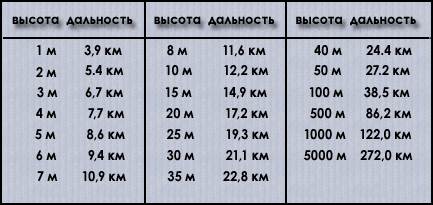
For eye estimation of distance, the following table can be used:
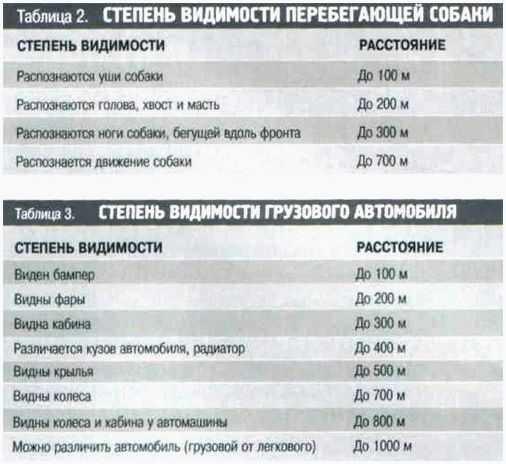
Features of a vision on a route of various subjects. Depend on many factors, and primarily on the distance to objects.
The further the object is located, the more it looks lower and narrower than it actually is.
Therefore, large objects seem to be closer than small ones. Lying objects (for example, a fallen tree) seem longer than standing in the same size:

When orienting and estimating the distance along the route, it must be remembered that the steepness of the exposed slopes seems usually larger than those of the forested ones; Distance to the distant forest, rivers, mountains - shorter than real; Smooth road - less long than the same road off-road.
Particularly "lengthen" kilometers passed under a heavy backpack, in bad weather or in conditions of poor visibility:
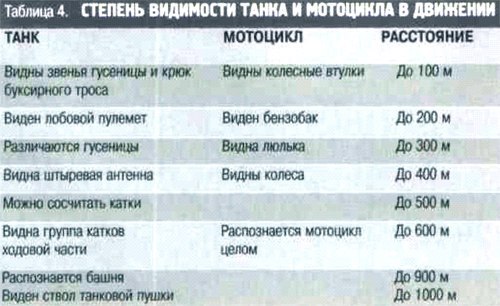
The distance on the water, in the gorge, on the snow seems shorter than the actual distance. The width of the river from a shallow shore is larger than when viewed from a steep bank.
When viewed from above upwards, from the foot of the mountain to its summit, the slope seems less steep, and the objects on the mountain are closer than when viewed from top to bottom, from the mountain. At night, all light sources and brightly lit objects appear much closer to their actual position.
In the daytime, bright objects painted in bright colors seem closer than dark objects or little contrasting with the natural background:
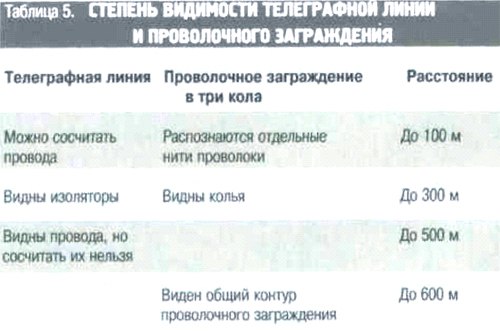
Table of the distance of the beginning of the visibility of objects:
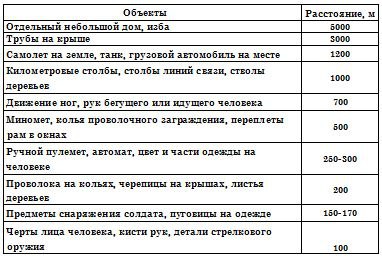
Determination of the distance using the AK-47/74 fly:
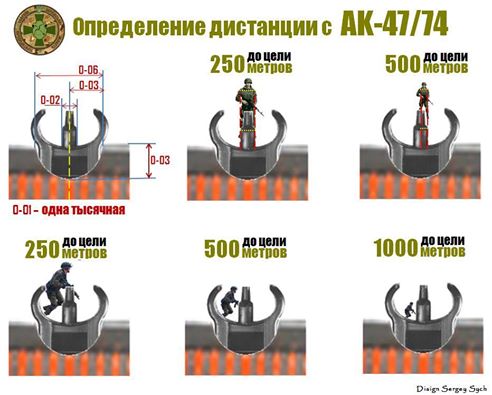
Naturally, these data are rounded, but this is an order of magnitude more accurate than determining the distance to the eye: The average height is 1.75 meters, running -1.5 meters, shoulders -0.5 meters, in winter clothes shoulders -0.6 meters.
Names of objects and Distance to them
Daytime:
.- Human settlements 10-12 km
- Large buildings 8 km
- Detached small houses 5 km
- Windows in houses (without binding) 4 km
- Pipes on roofs 3 km
- Individual trees 2 km
- People (in the form of dots) 1,5-2 km
- Movement of feet, hands of man 700 m
- Binders of window frames 500 m
- Head of a man 400 m
- Color and parts of clothes 250-300 m
- Leaves on trees 200 m
- Features of the face, hands 100 m
- Eyes (in the form of points) 60-70 m
- Bell towers and large towers 15000-20000 m
- Windmills 10000 m
- Villages and large houses 8000 m
- Windows in houses 4000 m
- Pipes on the roofs of 3000 m
- Individual trees 2000 m
- People as points of 2000 m
- Distinguish the rider from a pedestrian 1000 m
- Trunks of trees 900 m
- Distinguish the pedestrian from the horse 700 m
- Horse feet movement 600 m
- Bindings on windows 500 m
- Hand movement 400 m
- Colors and parts of clothes 250 m
- The human face of 200 m
- Roof tiles and boards 200 m
- Buttons and metal jewelry of clothes 150 m
- Facial expression 100 m
- Eyes (seem to be separate points) 70 m
- Eyes and mouth (clearly different) 35 m
- Eye whites 20 m
Night time:
.- Burning fire 6-8 km
- Light torch 1.5-2 km
- Burning match 1-1.5 km
- Fire cigarettes 400-500 m
Of course, with the eye-length determination of distances, one must take into account the fact that people's eyesight is different. Therefore, when using the table, you need to check the data in practice and make the necessary correction for yourself.
In addition, you should always remember:
- Brightly lit items seem closer. For example, a fire or a fire seems always closer to the true distance.
- Items painted in bright colors - white, yellow and red - seem closer.
- In the fog distances seem more, and after the rain, when there is no dust, - closer. At dusk, all objects seem farther away.
- When the sun is ahead of the observer, then the estimated distances are less, and when, the sun behind is more true.
- Large objects seem to be closer than small ones.
- Items on a flat surface seem to be closer than the same objects located on hilly terrain or behind any barriers. That's why the opposite bank of a river or lake always seems closer than it really is.
- When viewed from the bottom up, the objects appear to be closer than when viewed from top to bottom. For this reason, a person who is at the foot of a mountain, the mountain always seems steeper.
- The darker the background on which the object is, the more it seems. Because of this, the house against the sky always seems closer than the same house on a dark background of a forest or a mountain.
The accuracy of the eye measurement of distance depends on the skill, as well as on the magnitude of the measured distances. When determining distances over 1 km, the error can reach 50%. At small distances for experienced observers, the error does not exceed 10%.
Determining the distance by measuring angles
This method is more difficult to train. The starting point for measuring distances in this way is the following rule: each object visible at an angle of 1 ° is removed by a distance 57 times greater than its diameter. The object, visible at an angle of 2 °, is removed by 28 diameters; At an angle of 5 ° - by 11 diameters; At an angle of 7 ° - by 8 diameters, and so on. If the angle at which the object is visible is known, the distance to it can be approximately determined. The simplest way to measure is with your index finger. It is necessary to extend the hand and raise the index finger (the distance from the finger to the eyes is taken to be 60 cm). The object, which is covered with the fingernail of the index finger (nail width 1 cm), is usually seen at an angle of 1 ° and is 57 times larger than its diameter. If the nail covers only half of the object, then its angular value is 2 °, and the distance to it is 28 to its widths. For measurements, you can use the nail joint of the thumb. Its length is usually 3.5 cm. The object, which is covered with this joint with an elongated arm, is visible at an angle of 3 ° and is 18 times larger than its diameter.
Determination of the height of objects
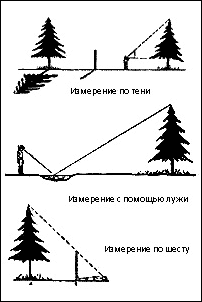
There are several simple ways to determine the height of objects. With some of them hunters should be familiar.
By the shadow. On a sunny day it is not difficult to measure the height of an object, suppose a tree, according to its shadow. You just need to be guided by the following rule: the height of the measured tree is so much greater than the height of the object known to you (for example, a stick or a gun), how many times the shadow from the tree is greater than the shadow from the stick. If, at our measurement, the shadow from the gun or stick is twice as long as the length of the shotgun or stick, then the height of the tree will be half the length of its shadow. In the same case, when the shadow of a gun or a stick is equal to their length, the height of the tree is also equal to its shadow.
On the pole. This method can be used when there is no sun and there is no shadow from the objects. To measure, you need to take a pole equal in length to your height. This pole must be installed at such a distance from the tree so that one can see the top of the tree on one straight line with the top point of the pole. Then the height of the tree will be equal to the line drawn from your head to the base of the tree.
In a puddle. This method can be successfully applied after the rain, when on the ground there are many puddles. The measurement is done this way: find a puddle not far from the measured object and become near it so that it fits between you and the object. After that, they find a point from which the top of the object reflected in the water is visible. The measured object, for example a tree, will be so much higher than you, at what distance from it to the pool is more than the distance from the puddle to you. Instead of a puddle, you can use a horizontally placed mirror.
Determination of the width of water bodies
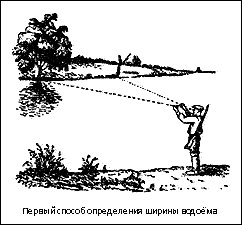
The first way. It is necessary to approach as close as possible to the water and notice on the opposite shore two objects located at the very edge of the water. Then you need to take a blade of grass (stick, string) and, holding it horizontally by the ends with both arms outstretched, close one eye. Looking over the blade of grass, we must close the gap between the observed landmarks. After this, note the point at which you are, fold the blade in half and move away from the reservoir at a right angle to another point from which the distance between the landmarks will be closed by a shortened blade of grass. The distance from this point to the river where you made the measurement for the first time will be equal to the width of the reservoir.
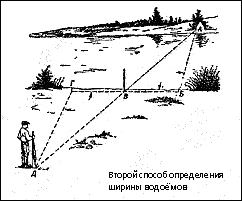
The second way. It is necessary to go to the water, to spot on the opposite shore any clearly visible object A, located at the very edge of the water, and mark the point of its standing with a stone or peg B. Then it is necessary to walk along the coast along a line perpendicular to the direction between A and B, exactly 30 steps, stick stick B, count 30 more steps and make a new note G. After that, turning your back to the shore, you need to go from the note Г to point D, until the stick is in line with the object behind the river A. The DG distance and Will be equal to the width of the pond
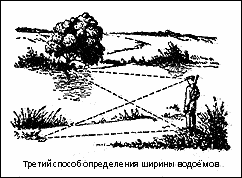
The third way. You need to put a cap or cap on your head, go to the very shore and look at it so that the canopy covers the shore. After this, without changing the inclination of the head, you should turn half-turned and notice the place on the shore, which is covered with a visor. The number of steps to this point on your shore will indicate the width of the pond. "
Orientation by sounds
The table shows the range of the beginning of the audibility of sounds in an open area in silence and at normal air humidity.
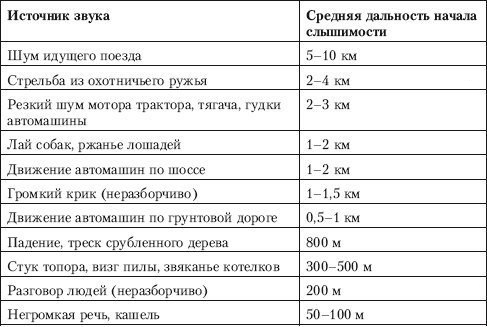
At night, and in the fog, when surveillance is limited or impossible at all (and on severely rugged terrain and in the forest, both at night and in the daytime), hearing is heard.
We must learn to determine the nature of sounds (that is, what they mean), the distance to the sources of sounds and the direction from which they originate.
If you hear different sounds, a person should be able to distinguish them from each other. The development of this ability is achieved by long training (in the same way a professional musician distinguishes the voices of instruments in the orchestra).
Almost all sounds that signify danger are produced by man.
Therefore, if a person hears even the faintest suspicious noise, he must stay still and listen.
It is possible that not far from him, the enemy lurked.
If the enemy begins to move first, thereby giving out his location, he will die first.
Similarly, an inexperienced or impatient hunter betrays his presence to the beast he hunts.
The skilled hunter with his endurance surpasses the animals.
In a quiet summer night, even an ordinary human voice in the open space can be heard far away, sometimes half a kilometer.
In a frosty autumn or winter night, all sorts of sounds and noises are audible very far.
This applies to speech, and footsteps, and clinking dishes or weapons.
In foggy weather sounds can also be heard far away, but their direction is difficult to determine.
On the surface of calm water and in the forest, when there is no wind, sounds are carried a very long distance.
But the rain is very jarring sounds.
The wind blowing in the direction of a man brings sounds closer, and o removes them.
He also puts the sound aside, creating a distorted view of the whereabouts of his source.
Mountains, forests, buildings, ravines, gorges and deep ravines change the direction of sound, creating an echo.
Echoes and water spaces are generated, contributing to its spread over long distances.
The sound changes when the source moves along a soft, wet or stiff ground, along a street, along a country road or field road, over a pavement or leafy soil.
It should be borne in mind that dry land transmits sounds better than air.
Therefore, listen with your ear to the ground or to the trunks of trees.
At night, sounds are well transmitted through the earth.
There are certain ways to help listen at night, namely:
- Lying: put your ear to the ground;
- Standing: one end of the stick to lean against the ear, the other end to rest in the ground;
- Leaning: standing, leaning forward slightly, moving the center of gravity of the body to one leg, with a half-open mouth, - teeth are the conductor of sound.
A trained person when stealing, if life is precious to him, lies down on his stomach and listens while lying, trying to determine the direction of the sounds.
This is easier done by turning one ear in the direction from which a suspicious noise is heard.
To improve hearing, it is advisable to attach bent hands, a bowler, a piece of pipe to the auricle.
For better listening to sounds, a person can put his ear to a dry plank laid on the ground, which serves as a collector of sound, or to a dry log dug into the ground.
If necessary, you can make a homemade water stethoscope.
To do this, use a glass bottle (or a metal jar), filled with water to the neck, which is buried in the ground to the level of water in it. In the cork tightly insert a tube (plastic), on which the rubber tube is put on. The other end of the rubber tube, provided with a tip, is inserted into the ear.
To test the sensitivity of the device, strike the ground at a distance of 4 m from the finger (the sound from the impact is clearly heard through the rubber tube).
Sources of sound (Average range of the beginning of audibility):
- The noise of a train going 5-10 km
- Shooting from the hunting gun 2 - 4 km
- Sharp noise of the motor of the tractor, tractor, the whistle of the car 2 - 3 km
- Lai dogs, horse neighing 1-2 km
- Car traffic along the highway 1 2 km
- Loud scream (illegible) 1-1.5 km
- Movement of vehicles along a dirt road 0.5-1 km
- Falling, cracking of felled tree 800 m
- The knocking of an ax, the screeching of a saw, the clinking of pots 300-500 m
- People speaking (illegible) 200 m
- Soft speech, cough 50-100 m


Comments
Commenting on, remember that the content and tone of your message can hurt the feelings of real people, show respect and tolerance to your interlocutors even if you do not share their opinion, your behavior in the conditions of freedom of expression and anonymity provided by the Internet, changes Not only virtual, but also the real world. All comments are hidden from the index, spam is controlled.